____________________________________
The preceding article Dysfunctional Amphibious Ships explains why the US Navy no longer has an amphibious invasion capability. The US Navy needs small, oceangoing ships to offload combat power directly ashore, like the Landing Ship Tank (LST) developed during World War II to allow vehicles to drive directly onto shore. Watch this excellent documentary to understand the value of these ships. The US Navy needs inexpensive, armed, oceangoing ships that can absorb and return fire while depositing combat power directly on hostile shores without ultra-expensive "connectors". A long-term plan to construct a hundred truly amphibious ships would cost no more than current plans for more huge luxury cruise ships (called LX(R)s) that cost over $2 billion each and cannot quickly land and support forces ashore.
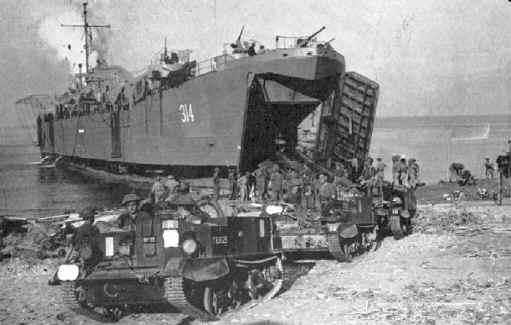 A
modern LST should be similar to those used in World War II (pictured), unlike the US Navy's
last class of LSTs, retired in the 1990s. These Newport
LSTs were much bigger to sail faster and "keep up" with big
warships during long, overseas deployments. This odd demand resulted
in a much deeper draft that didn't allow beaching and required a heavy folding bow ramp that
did not allow forward firing weaponry. If the US military still desires the
capability to land ground forces on hostile shores, it requires an improved LST
that does more than just land tanks, called a Landing Ship Assault (LSA).
A
modern LST should be similar to those used in World War II (pictured), unlike the US Navy's
last class of LSTs, retired in the 1990s. These Newport
LSTs were much bigger to sail faster and "keep up" with big
warships during long, overseas deployments. This odd demand resulted
in a much deeper draft that didn't allow beaching and required a heavy folding bow ramp that
did not allow forward firing weaponry. If the US military still desires the
capability to land ground forces on hostile shores, it requires an improved LST
that does more than just land tanks, called a Landing Ship Assault (LSA).
LSAs can also provide unique transport for non-combat transport missions. When LSTs arrived during the middle of World War II, they were mostly used for basic transport. Few islands in the Pacific area of operations had seaports to offload ships, and these few ports were often attacked by air. LSTs could offload supplies almost anywhere. In Europe, LSTs delivered supplies directly to forward forces along a coast. In Korea, LSTs were used to evacuate trapped Marines. In Vietnam, LSTs delivered cargo up rivers. In a future war or humanitarian crises, American forces will find themselves far from a deepwater port, or port activity is hampered by missile attacks or hostile locals. In such cases, vital supplies can be delivered directly to any beach by LSAs.
Ships Can Survive Shore Fire
The US Navy now argues that ships can no longer approach the shore of a modern enemy because ships are easily sunk by precision guided missiles. This is true for big, multi-billion dollar warships packed with explosive missiles and dangerous aviation fuel. These lucrative targets may explode like ammunition ships after a minor hit.
Many US Navy ships were hit dozens of times during World War II, yet continued to function since they didn't carry explosive missiles or aviation fuel (aircraft carriers excepted). Shore fire can knock holes in ships and cause damage and casualties, but this will not cause a ship to blow up or burn intensely unless it ignites missiles or volatile aviation fuel. The US Navy only lost 26 LSTs to enemy action out of 1051 constructed during World War II. Read this excellent report on LST damage during World War II that includes:
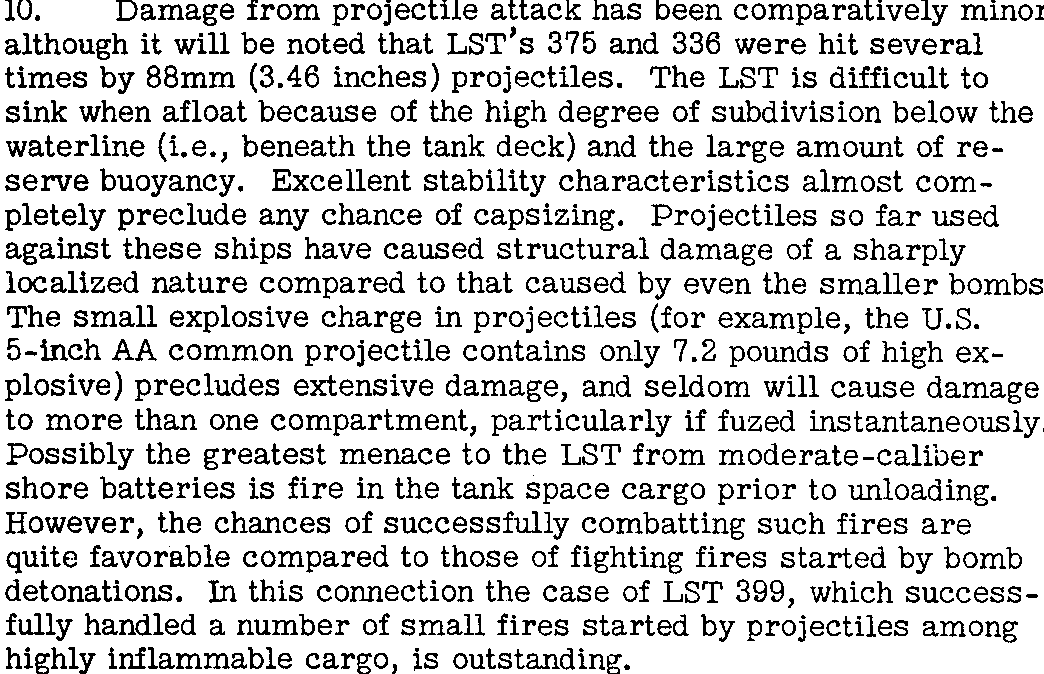
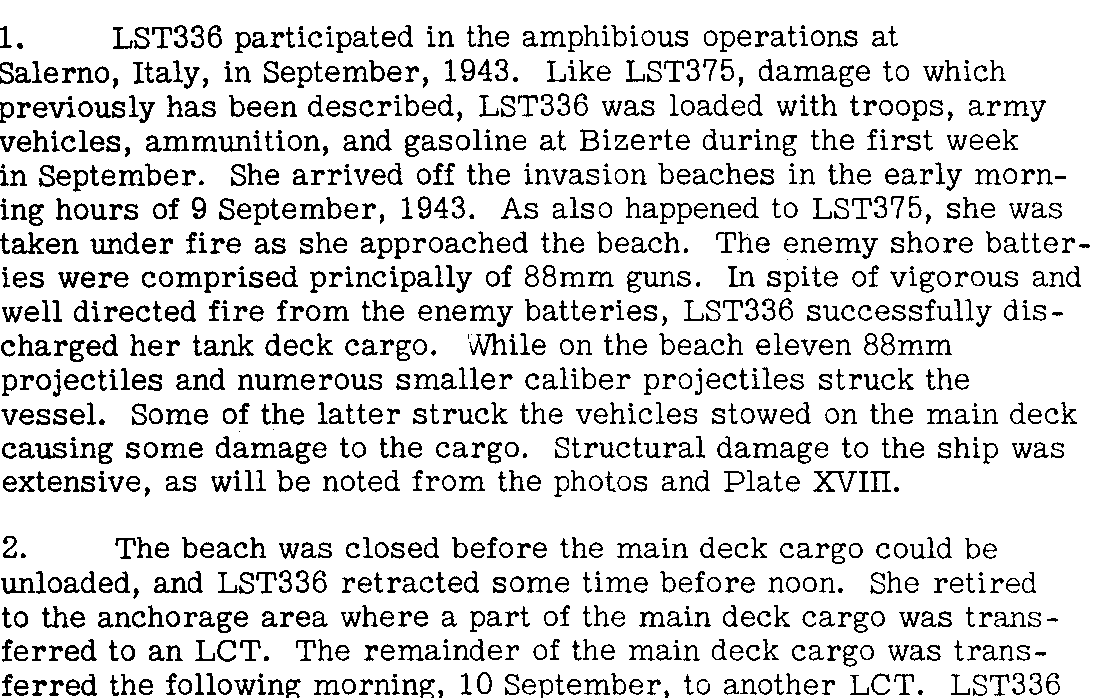
The only times LSTs suffered intensive damage from enemy action occurred while transporting barrels of aviation fuel. They were not designed for this role and when enemy fire ignited the fuel it overwhelmed their firefighting capabilities. As a result, LSAs should not carry fuel or ammo stores. These can be landed by much smaller LCUs launched from ships far offshore that land after shore fire has been suppressed. LSAs will not carry missiles or aviation fuel so if heavily damaged by shore fire they can survive to beach themselves and accomplish their mission.
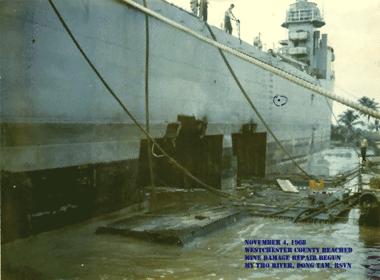 The
powerful water pump systems used by LSTs to expel ballast before the ship beaches
also provide a great damage control capability.
During the Vietnam War, LSTs were used inland to support operations and
were targeted for attack. The USS Westchester
County served as a mobile base to
support riverine forces in Vietnam. On Nov 1, 1968, VC commandos attached two
large bombs to her hull and swam away. The explosion
knocked two huge holes in the ship, killing 25 men aboard and wounding 27.
Nevertheless, the
crew managed to beach the ship to avoid sinking. (pictured)
The
powerful water pump systems used by LSTs to expel ballast before the ship beaches
also provide a great damage control capability.
During the Vietnam War, LSTs were used inland to support operations and
were targeted for attack. The USS Westchester
County served as a mobile base to
support riverine forces in Vietnam. On Nov 1, 1968, VC commandos attached two
large bombs to her hull and swam away. The explosion
knocked two huge holes in the ship, killing 25 men aboard and wounding 27.
Nevertheless, the
crew managed to beach the ship to avoid sinking. (pictured)
Modern weapons are far more lethal than in previous wars. In a massive amphibious invasion led by dozens of LSAs, some may be sunk while others are damaged on their way to the beach. However, warships are built for wars, and ship losses should be expected. LSAs might be hit by big guided anti-ship missiles, but an LSA is a small, unimpressive target that an enemy may know is difficult to sink. These missiles cost millions of dollars and are limited in number, so an enemy will prefer to target larger and far more expensive ships far offshore.
Protecting
LSAs 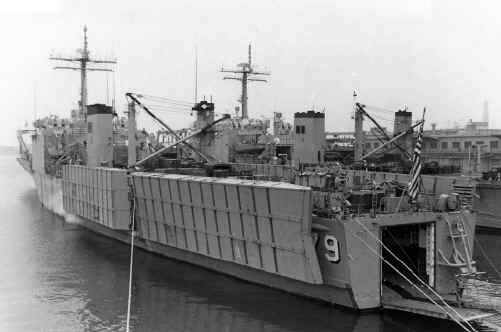
Despite the LSTs great record, several survivability enhancements are possible for LSAs. An autocannon should be mounted on the bow as was standard in World War II. This could be the US Navy's common MK 46 30mm autocannon or the radar guided CWIS 20mm gatling gun. A 40mm autocannon like the Italian DARDO can provide greater range and explosive power.
LSAs can also carry pontoons alongside, as was common during World War II. Even with a shallow draft, LSTs sometimes needed several feet of floating ramp to offload vehicles. Pontoons were carried alongside (pictured) and dropped so that Seabees could rapidly assemble them, even under fire. Pontoons also provide great protection from missiles, absorbing most of the blast.
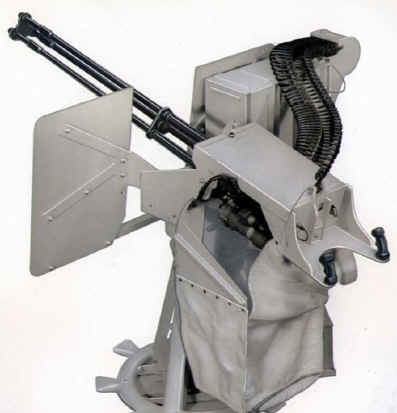 Adding
more weaponry is possible, but these add weight, complexity, and crew size.
Simple alternatives should be considered. The US Navy views landing
force passengers as cargo to remain in
berthing spaces during transit, rather than manpower to augment the crew.
Once Marines are embarked, some should be selected and trained for ship firefighting and gun ammo support.
Adding
more weaponry is possible, but these add weight, complexity, and crew size.
Simple alternatives should be considered. The US Navy views landing
force passengers as cargo to remain in
berthing spaces during transit, rather than manpower to augment the crew.
Once Marines are embarked, some should be selected and trained for ship firefighting and gun ammo support.
LSAs should have numerous simple yet effective weapons, like the GAU-19 .50 cal/12.7mm gatling gun (pictured) to be manned by passengers. This gun can fire up to 33 rounds a second, so with four guns firing at an incoming missile less than 1000 meters away and closing, it will encounter 120 bullets a second, and at least one lucky shot is sure to hit. Missiles inbound at a ship are clearly visible for several seconds and a mass volley of heavy bullets should prove effective as it was against Kamikazes during World War II. These guns can also blast shore targets as the LSA unloads. These gunners would be chosen among the last to offload with their vehicles, so can continue to fire away for several minutes after the LSA beaches, or longer if pontoons must be assembled. If mortars are embarked, crews may set up to fire from the stern flight deck. Accuracy while underway will be limited, but once the LSA beaches, mortars can provide effective fire support while LSAs unload.
 Another
idea for protection is the old torpedo
net idea expanded to serve as missile nets. (pictured). Long booms
with metal nets would cause missiles, torpedoes, or mines to explode before
impacting the ship. Since this adds weight and some complexity, these systems
may be mounted on just a few LSAs designated to lead the charge ashore. These survivability enhancements
are unlikely to stop a large incoming missile, but should cause it to explode
outside the ship so that it only suffers minor damage.
Another
idea for protection is the old torpedo
net idea expanded to serve as missile nets. (pictured). Long booms
with metal nets would cause missiles, torpedoes, or mines to explode before
impacting the ship. Since this adds weight and some complexity, these systems
may be mounted on just a few LSAs designated to lead the charge ashore. These survivability enhancements
are unlikely to stop a large incoming missile, but should cause it to explode
outside the ship so that it only suffers minor damage.
Modern technology allows other enhancements. A backup bridge to control the ship should exist in a small armored compartment linked to HD cams. If the bridge is threatened, the command crew rushes into this room for protection. The ship should also have APU battery packs to keep things working should electrical power be lost. Such enhancements can ensure LSAs make it to shore. Keep in mind that no LST was sunk by shore fire during all of World War II; 87 LSTs hit the beach at heavily defended Iwo Jima and none suffered serious damage.
LSA Fire Support
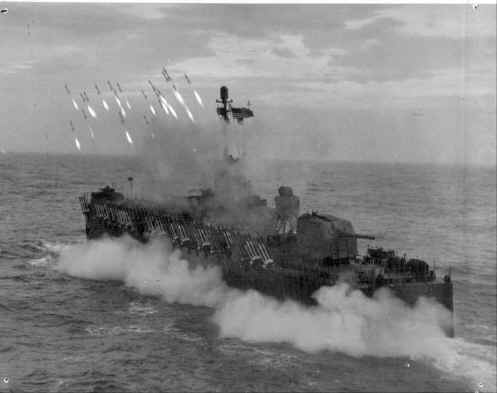 During
World War II, US Navy surface combatants were often tasked with naval gunfire
support missions. Admirals decided this basic task could be performed by smaller
ships with fewer crewmen. Twelve Landing Ship Medium (LSM)s were converted to LSM(R)s.
These were much smaller than LSTs but carried a 5-inch gun and a rocket system.
(pictured)
During
World War II, US Navy surface combatants were often tasked with naval gunfire
support missions. Admirals decided this basic task could be performed by smaller
ships with fewer crewmen. Twelve Landing Ship Medium (LSM)s were converted to LSM(R)s.
These were much smaller than LSTs but carried a 5-inch gun and a rocket system.
(pictured)
As World War II ended, the US Navy began construction of the USS Talbot County class of LSTs, which included two 5-inch guns. Since the US Navy is reluctant to send its multi-billion dollar destroyers and cruisers near shore to provide 5-inch gun support, LSA Fire Support (LSAF)s are needed. Their armament is up for debate, but two 5-inch guns would be practical, along with a rocket or automatic mortar system. In addition, counter-battery radar is needed. Navy 5-inch guns have a range of just 13 miles with standard ammunition, but this is less a problem for an LSAF that fire from the shoreline and can venture up rivers and inlets.
LSA Recovery
During World War II, it was quickly discovered that an LST recovery variant was needed since damaged LSTs often beached themselves. LST "tenders" were outfitted and known as ARSTs, like the USS Laysan Island. With a shallow draft, these ships could pull alongside damaged LSTs and LCUs to perform repairs. Therefore, a few LSA Recovery (LSAR)s are a good idea, with machine shops, spare parts, and repairmen to assist LSAs. LSARs should have powerful water cannons to hose down LSAs on fire. Finally, they should have a heavy crane to snatch injured personnel off a burning or sinking LSA, which can also be used to lift vehicles off stranded ships. Since the US Navy has no combat recovery ships, LSARs would be dispatched to assist any heavily damaged warship.
Since LSAs will have a small crew, they will have no medical facilities. As a result, LSARs should also have operating rooms and medical personnel to support other LSAs and landing forces. During World War II, 38 LSTs were converted to serve as LSTH hospital ships. The US Navy has no ships like LSARs in the fleet, so will dispatch them to assist any damage ship.
A major amphibious landing could see 50 LSAs charging toward landing beaches. Mines may not be an issue or a major challenge best discussed in another article. The basics of amphibious operations can be read here: Amphibious Warfare. If defenses are strong, perhaps half of the LSAs will be hit but most will only suffer minor damage. Perhaps a dozen will suffer serious damage but continue underway and beach themselves to deliver their landing force and await repairs from LSARs while continuing to provide shelter and support to the landing force.
Some LSAs may be immobilized or suffer severe damage that threatens sinking. These ships will open their stern gate to launch AAVs and lower their landing craft to send embarked Marines to the beach by foot. This is also done whenever offloading is delayed because pontoon assembly is required, and offloading this weight will lighten the ship allowing it rise higher. An LSAR should quickly arrive to assist and evacuate casualties. LCUs returning from the beach will head toward disabled LSAs to load their vehicles from its stern gate while the LSAR crane removes cargo. Other LSARs will land on the beach to treat casualties and repair damaged LSAs and LCUs. Recall that no LSTs were lost to shore fire during all of World War II. LSAs might be sunk, but immediate LSAR aid will ensure that personnel and most cargo are rescued.
LSAs
Can Land Anywhere 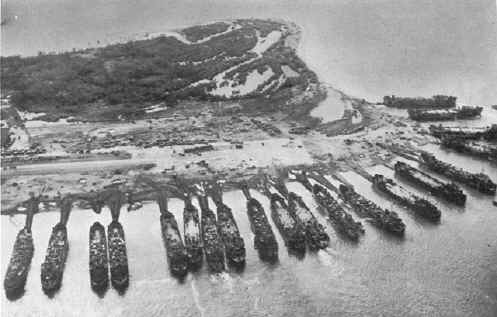
LSAs provide a major strategic advantage since they can instantly land a large force on any beach. In 1944, the Japanese had 432,000 soldiers in the Philippines. With thousands of islands, these forces could not defend all possible landing sites. They planned to use airpower to smash a landing force on the beach within hours and use road mobility to move large units to landing points within days. Japanese forces on the large island of Leyte were few since it was assumed the Americans would land on the big southern island of Mindanao within range of American land based attack aircraft.
General MacArthur surprised the Japanese with a new type of ship -- the LST! These swarmed undefended Leyte beaches and offloaded large forces before the Japanese high command was aware that a landing was underway. LSTs are pictured above at Leyte in 1944. Note these LSTs were unable to land at this shallow beach, and this was not uncommon. Many beaches are so shallow that even much smaller landing craft cannot reach shore, as MacArthur's famous "return to the Philippines" photo showed him sloshing ashore.
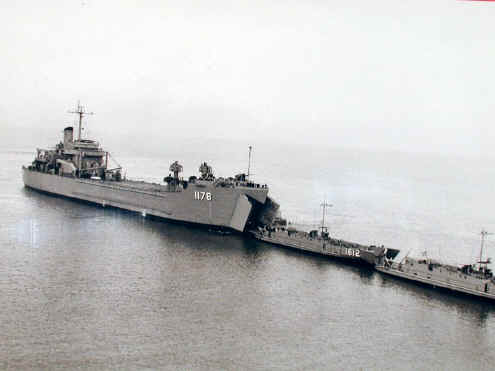 As
a result, a "lighterage" system of floating piers was developed so pontoons
could be assembled like Lego blocks. The US Navy formed Amphibious Construction
battalions to assemble these into causeways that proved vital in almost every
landing. LSTs could quickly employ these systems when needed, as they were at
Leyte.
As
a result, a "lighterage" system of floating piers was developed so pontoons
could be assembled like Lego blocks. The US Navy formed Amphibious Construction
battalions to assemble these into causeways that proved vital in almost every
landing. LSTs could quickly employ these systems when needed, as they were at
Leyte.
An LSA can provide another 300 feet of causeway to deeper water using its stern ramp. This depends on the grade of the beach and the draft of the cargo ship. Smaller transports like the US Navy's new fast Spearhead T-EPF have a 12.5 foot draft, which limits their expeditionary capability to offloading at existing piers. After an LSA offloads, a Spearhead could pull up behind and lower its vehicle ramp to the LSA's stern gate to offload directly to shore through the LSA! An LSA like an LST could even marry up with LCUs (pictured) to instantly provide a causeway for large ships to offload.
The value of causeways has been forgotten in the Navy and Marine Corps, which haven't conducted or even practiced a major amphibious invasion since 1950. This led to the acceptance of the impractical idea of "seabasing." Rather than quickly offloading cargo directly on a causeway in a few hours, ships will park 100 miles offshore and offload onto floating lighterage. (pictured below) Calm seas are required as a cargo ship slowly offloads onto LCUs and LCACs for days since they require hours for each trip. No one explains how these unarmed thin-skinned landing craft will survive shore fire from tank guns and anti-tank missiles. Hopefully, enemy attack boats and submarines will not venture down the coast and follow landing craft back to the huge stationary cargo ships.
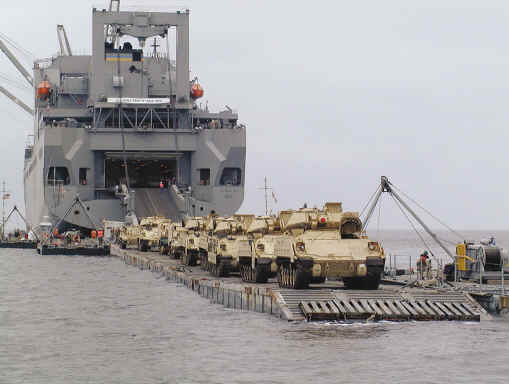 G2mil
has an article that details the impracticality of this concept: "Thoughts
on Seabasing." Here is part that summarizes why this idea is
unsound:
G2mil
has an article that details the impracticality of this concept: "Thoughts
on Seabasing." Here is part that summarizes why this idea is
unsound:
First, sealift is finite and armies usually have many times more tonnage to move than sealift. Therefore, they "stage" near an objective area, then use their limited sealift to shuttle these resources after a surprise landing. If ships must linger offshore to provide seabased support, they are unavailable to shuttle supplies from staging areas. Second, a seaborne landing quickly attracts the attention of enemy commanders who vector their ships, attack boats, missiles, submarines, commandos, and attack aircraft toward that area. It is much safer for a ship to offload cargo and depart rather than loiter offshore like a duck in a shooting gallery. Moreover, supplies ashore cannot be sunk by a single torpedo or missile. Since many ships are filled with explosive fuel and ammo, ship captains are likely to run at the first sign of an enemy threat.
When the LSTs were retired, the US military lost its capability to conduct major amphibious invasions. Without LSTs or future LSAs to assemble causeways, a deep water port must be seized, unless the enemy has no serious weaponry so that cargo ships can anchor close to shore. This works far better if cargo ships connect their lighterage to an LSA built causeway or even to the stern ramp of an LSA. The loss of this option is why knowledgeable naval officers dismiss the idea of attempting a major amphibious operation by offloading 100 miles or even 25 miles offshore.
A Fleet of LSAs
If the US Navy constructs 100 LSAs over 25 years, a fleet of 84 LSA transports should be built along with 8 LSAFs and 8 LSARs. Slow, frugal LSAs will not make routine overseas deployments. A few will be based overseas to support exercises and operations just like big prepo sealift ships. Most will remain stateside to train crews, support amphibious training, transport Navy cargo between coastal ports, and use their unique capability to support natural disaster relief operations.
 Perhaps half
of these new LSAs will be placed in an inactive status for wartime use. This
seems odd but a major amphibious landing cannot occur until air and naval
superiority is achieved. In addition, it will require months to transport and stage supplies
overseas for a major amphibious invasion. All this will require the mobilization
of reserve logistics units and the production of additional stores of ammunition.
As a result, there is no need to keep half of LSAs on active duty. These can be
maintained in various levels of readiness that may require a few weeks of yard work
to be ready for war. Some new LSAs may be preserved without computers and other electronic
systems since these would be outdated within a decade, yet can be added
when needed.
Perhaps half
of these new LSAs will be placed in an inactive status for wartime use. This
seems odd but a major amphibious landing cannot occur until air and naval
superiority is achieved. In addition, it will require months to transport and stage supplies
overseas for a major amphibious invasion. All this will require the mobilization
of reserve logistics units and the production of additional stores of ammunition.
As a result, there is no need to keep half of LSAs on active duty. These can be
maintained in various levels of readiness that may require a few weeks of yard work
to be ready for war. Some new LSAs may be preserved without computers and other electronic
systems since these would be outdated within a decade, yet can be added
when needed.
During wartime, the US military implements a "stop-loss" so that servicemen are not allowed to retire or leave at the end of their enlistment. This provides an instant surplus of sailors that can be sent to LSA training ships to train crews for the reserve LSAs being outfitted in yards. However, the bulk of their crews will come from mobilization of the naval reserve by recalling recently retired sailors and recently released sailors who are still under a wartime IRR contract for four years. These sailors already have the needed skills to quickly learn the simple LSA crew tasks. As a result, the US Navy could have all reserve LSAs outfitted, crewed, and ready to deploy within six months.
Affordable LSAs
An LSA must be big enough to cross oceans and take hits and keep on steaming. Small enough for a shallow draft to allow beaching to offload. Efficient so that all available space is used to embark the landing force. Finally, cheap enough to be unattractive to target with rare multi-million dollar anti-ship missiles. Much of the cost savings and efficiency result from limited crew and passenger comforts since these ships will not be expected to make 6-8 months overseas deployments. LSAs must be designed to load a landing force, sail for week, and deposit it ashore. Modern technology and short deployments should allow an LSA crew of around 100 sailors; the Newport LST class had 224.
LSA design can benefit from modern LSTs constructed in recent years, like the Bayraktar from Turkey, the Jason from Greece, the Cheonwangbong from South Korea, and the Endurance from Singapore. (Lots of info and great photos of the Jason class can be seen here.) If traditional US Navy shipbuilders show no interest in low-cost/low-profit LSAs, or bid much too high, the Navy should contract with a foreign shipbuilder to make them in the USA. Dutch shipbuilder Damen offers a variety of landing ships, including an LST with a crew of just 22, and will help build them in any shipyard. Watch his impressive video of their offerings.
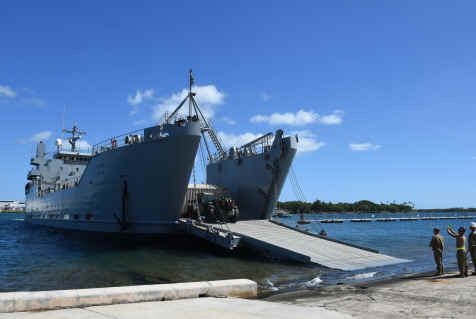 The US Army uses smaller American shipyards to build their
simple, low-cost transport ships. In
September 2017, the US Army awarded
a contract to Vigor in Portland for new landing craft. The
Army already operates eight Besson
LSVs recently built by Halter Marine in the USA. (pictured) The Army
calls its ships "vessels" and configures them as open landing craft
with no weaponry to overcome objections from the Navy and Congress. This limits
cargo since an upper deck is missing and all is exposed to the weather, but it
still carries up to 15 heavy tanks. Smaller shipyards are willing to build simple LSAs likely shunned by the
Navy's current shipyards that prefer contracts for complex, multi-billion dollar
warships.
The US Army uses smaller American shipyards to build their
simple, low-cost transport ships. In
September 2017, the US Army awarded
a contract to Vigor in Portland for new landing craft. The
Army already operates eight Besson
LSVs recently built by Halter Marine in the USA. (pictured) The Army
calls its ships "vessels" and configures them as open landing craft
with no weaponry to overcome objections from the Navy and Congress. This limits
cargo since an upper deck is missing and all is exposed to the weather, but it
still carries up to 15 heavy tanks. Smaller shipyards are willing to build simple LSAs likely shunned by the
Navy's current shipyards that prefer contracts for complex, multi-billion dollar
warships.
A very long-term multi-year contract to produce four LSAs each year for a billion dollars would be nice. This would be a 25-year production run for a $25 billion program, and probably longer as these affordable, practical ships should attract foreign buyers. This is easily affordable if the Navy cancels plans to replace 12 LSDs with much larger $2 billion LPDs called the LX(R), which also require expensive LCACs. These ships cannot rapidly land forces ashore, are too big and expensive to risk near shore, and cannot assemble causeways to allow cargo ships to offload directly to shore. The loss of LSDs will change the composition of Amphibious Ready Groups, which are small task forces that make routine peacetime deployments, but this is long overdue and will be explained in the next article. A hundred LSAs will restore the US Navy's amphibious invasion capability and satisfy political demands for a larger US Navy fleet.
Carlton Meyer editorG2mil@Gmail.com
©2018 www.G2mil.com